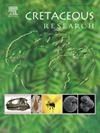Eolian-fluvial succession in the Early Cretaceous from the Ordos Basin
IF 1.9
3区 地球科学
Q1 GEOLOGY
引用次数: 0
Abstract
Cretaceous eolian deposits are widely developed in North China, among which the Lower Cretaceous eolian (erg) sedimentary strata in the Ordos Basin are the most representative. Many studies have been conducted on eolian deposits in the Ordos Basin, especially the Luohe Formation; however, there is a lack of systematic sedimentology research and the corresponding research on the evolution of sedimentary facies. Therefore, to explore the Mesozoic drought events and the systematic evolution of the sub-tropical erg zone, this study reports the fluvial–eolian sedimentary sequences of the Early Cretaceous Luohe and Yijinhuoluo Formations in the Ordos Basin. Spatially, through detailed sedimentary lithofacies and structural analysis of different outcrops, the combination law of sedimentary facies can be determined. Based on this, a three-dimensional sedimentary model of erg is reconstructed. The erg environment is divided into three sub-environments: erg margin, erg margin–centre transition and erg centre. According to the evolution of the sedimentary facies, the sedimentary evolution from the Latef Jurassic to the Early Cretaceous in the Ordos Basin is divided into five stages. The Ordos Basin has experienced the delta, erg formation, erg deposition, erg shrinkage and evaporating salt-lake stages. The vertical sedimentary evolution indicates climatic oscillation in North China from the Late Jurassic to the Early Cretaceous. Under the control of the sub-tropical high belt, the Ordos Basin experienced a hot and arid climate during the Cretaceous, forming a widely distributed erg belt in the region. During this period, a small-scale climate shock occurred under the hot and arid background, changing the sedimentary environment.
鄂尔多斯盆地早白垩世的风化-流积演替
华北地区白垩纪沉积广泛发育,其中以鄂尔多斯盆地下白垩统沉积地层最具代表性。关于鄂尔多斯盆地沉积,尤其是漯河地层的研究很多,但缺乏系统的沉积学研究和相应的沉积面演化研究。因此,为探讨中生代干旱事件和亚热带糜棱带的系统演化,本研究报告了鄂尔多斯盆地早白垩世漯河地层和伊金霍洛旗地层的河流-风化沉积序列。在空间上,通过对不同露头的详细沉积岩相和构造分析,确定了沉积面的组合规律。在此基础上,重建了鄂尔多斯盆地的三维沉积模型。尔格环境被划分为三个子环境:尔格边缘、尔格边缘-中心过渡带和尔格中心。根据沉积面的演化,将鄂尔多斯盆地晚侏罗世至早白垩世的沉积演化划分为五个阶段。鄂尔多斯盆地经历了三角洲期、额尔古纳形成期、额尔古纳沉积期、额尔古纳收缩期和盐湖蒸发期。垂直沉积演化显示了华北地区从晚侏罗世到早白垩世的气候震荡。在亚热带高原带的控制下,鄂尔多斯盆地在白垩纪经历了炎热干旱的气候,在该地区形成了分布广泛的鄂尔浑带。这一时期,在炎热干旱的背景下发生了小规模的气候震荡,改变了沉积环境。
本文章由计算机程序翻译,如有差异,请以英文原文为准。
求助全文
约1分钟内获得全文
求助全文
来源期刊

Cretaceous Research
地学-地质学
CiteScore
4.10
自引率
19.00%
发文量
235
审稿时长
12 weeks
期刊介绍:
Cretaceous Research provides a forum for the rapid publication of research on all aspects of the Cretaceous Period, including its boundaries with the Jurassic and Palaeogene. Authoritative papers reporting detailed investigations of Cretaceous stratigraphy and palaeontology, studies of regional geology, and reviews of recently published books are complemented by short communications of significant new findings.
Papers submitted to Cretaceous Research should place the research in a broad context, with emphasis placed towards our better understanding of the Cretaceous, that are therefore of interest to the diverse, international readership of the journal. Full length papers that focus solely on a local theme or area will not be accepted for publication; authors of short communications are encouraged to discuss how their findings are of relevance to the Cretaceous on a broad scale.
Research Areas include:
• Regional geology
• Stratigraphy and palaeontology
• Palaeobiology
• Palaeobiogeography
• Palaeoceanography
• Palaeoclimatology
• Evolutionary Palaeoecology
• Geochronology
• Global events.
 求助内容:
求助内容: 应助结果提醒方式:
应助结果提醒方式:


